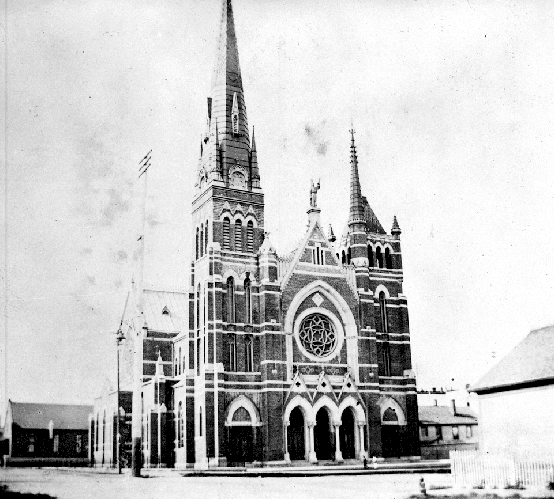St. Andrew's Cathedral
“Bless, O Lord this creature of stone, and grant by the invocation of thy Holy Name, that whosoever with a pure mind, shall give aid to the building of this Church may receive health of body and healing of mind. Through Our Lord, Christ : Amen.” -Right Rev. Bishop Lootens

St. Andrew's Cathedral on the corner of View and Blanshard Street (1890s).
The cornerstone of St. Andrew’s Cathedral was laid on October 5th, 1890 by the Catholic community of the Pacific West Coast and it is unique among the cornerstones on this site because of its size and the manner in which it connects to the time capsule.With dimensions of 5x5x3 feet, the cornerstone actually played a structurally integral role to the building. The five and a half ton block came from Keefer’s quarry in the Burrard Inlet. It matches similar stones around the base of the building, but bears the name of Reverend Bishop John Nichola Lemmens, who oversaw the project from start to finish.
A week before the ceremony, Lemmens announced that the names of subscribers (people who donated to the building project) and the amount subscribed up to date would be deposited within the cornerstone during the ceremony. Estimated costs for the construction of the church went upwards from $80,000 in 1890. During the week, nearly $15,000 worth of donations came pouring into the project, bringing the total amount raised by the time of the ceremony to approximately $45,000.
The Victoria Daily Colonist began covering news of the construction as soon as it was underway, months before the cornerstone was laid, and paying special attention to the permanency of the structure. Lemmens worked with Montreal architects to design a church like one he had seen in Quebec the Church of Longeuil, imitating the European cathedrals of the fourteenth and fifteenth century, while he travelled back and forth between Victoria and Kyuquot Sound, BC.
As a missionary, Lemmens worked closely with the indigenous people from Kyuquot Sound to Victoria and in other parts of the country. He was intimately aware of the ruggedness of missionary frontier life and worked cooperatively with other missionaries, settlers, and indigenous people to survive. In his diary, he even talks about a prominent figure in the Catholic community working with the labourers in a sawmill near Kyuquot Sound, when help was needed.
In practice, Rev. Lemmens daily life brought him into contact with labourers and indigenous peoples, but the Victoria Daily Colonist makes no mention of diversity amongst the crowds gathered at the cornerstone ceremony or the opening of the church.
Click here to learn more about St. Andrew's Ceremony
Click here to learn about Rev. Lemmens
Click here to view St. Andrew's References






